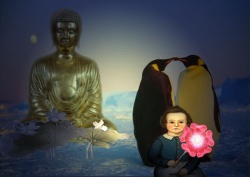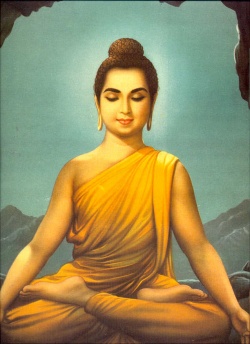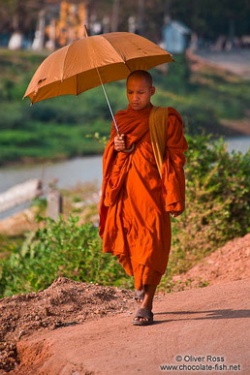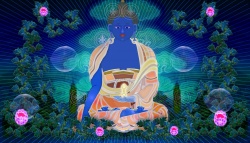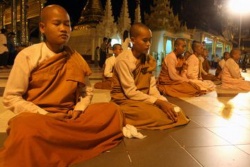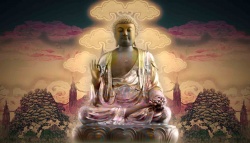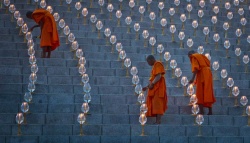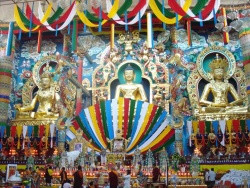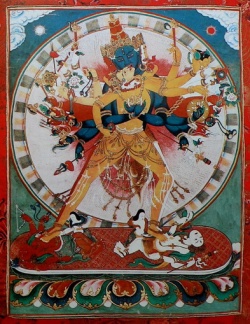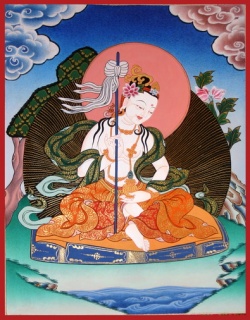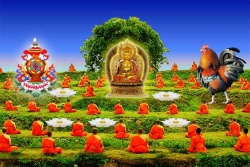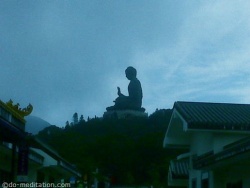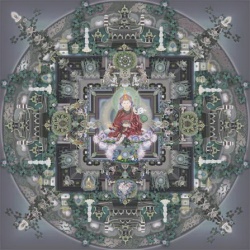Life Stories of the Buddha’s Six-Fold Perfection
The First Paramita — Charity (Dana)
The Story of Deer Park
Once upon a time, there lived this Deer King, tall and handsome, with furs glowed five colors. He and hi s herd of thousands roamed free in the forest. One day, a royal king and his entourage discovered this forest and went hunting; they hurt and slaughtered many of the deer.
The Deer King was greatly grieved at the sight of so many fallen an d his loving heart was filled with sorrow. He went to see the human king and pleaded, in human language, “I believe in your he art you know every living being treasures its own life. So please spare us the fear of losing ours everyday. Allow us offering one of us to you each day and stop the massacre.” Th e human king was surprised but consented to this arrangement.
The day came when it was the turn of a pregnant mother-doe. She begged to the Deer King to delay her death until her child is born. The Deer King took pity on the despairing mother-doe, but could not send anyone else to die for her. He decided to offer himself as the sacrifice of the day. When the human king saw the Deer King, he was surprised and asked, “Are there no more deer left?”
Realizing the Deer King’s decision, he was deeply touched and reflected: “The Deer King is but an animal yet he has such compassion for hi s fellow beings. I am the king of human beings, but I kill to satisfy my own appetite. I am less a being, let alone a king, than the Deer King.” With this understanding, the king swore off all animal flesh from his diet. He made it the law of land that no deer shall be harm ed or killed ever again. The forest was reserved for the deer and became known as Deer Park in India.
The Deer King was one of the former incarnations of Shakyamuni Buddha.
Tale of a Sage's Sacrifice to Save Tigers
Long time ago, a Brahman was living in the mountain , striving to cultivate Buddhism by not committing any sins and treating all sentient beings with great compassion. One day, the Brahman was searching for food and discovered a female tiger, who had just given birth to several baby cubs. The tiger was exhausted with no strength to hunt, and thus could not produce milk to feed the young cubs. Without much choice the tiger ate one of he r baby cubs in order to gain nutrients to produce milk to feed cubs. The Brahman felt heartbroken when he saw what happened : “There is no end in the sufferings of sentient beings. There are no words that could describe how painful the mother tiger felt to have to eat her own cubs.” Tearfully he searched for food to feed the hungry tiger to save the young cubs.
The Brahman thought “The purpose for cultivating Buddhism is to eliminate the suffering of sentient beings, and to turn their suffering to happiness. I will get old and die eventually. I should sacrifice my body so the mother and her cubs could all survive.” Having so decided, he moved hi s head toward the mother tiger’s mouth and fed himself to the tiger.
This was one example of how Śākyamuni Buddha sacrificed himself to save others. Because of his fearless and selfless charity, he shortened the span it takes to attain Buddha hood by nine kalpas, perfected the practice of dana paramita, and became the great spiritual teacher, and as sisting all sentient beings in the process of liberation.
The Second Paramita — Moral Conduct (Sila)
The Tale of the White Elephant
In a forest long ago there was a white elephant king with six tusks who led a herd of 500 other elephants. The white elephant took the Three Refuges and vowed to assist all sentient beings to attain enlightenment. He had two wives, one of the wives was jealous of the other receiving more attention from the elephant king. She made a curse to destroy the elephant king in the future. Plagued by jealous an d upsetting thoughts she soon passed away and was reborn as a smart and beautiful lady who was soon married to the King.
One day the queen told the king that she had dreamt of a white elephant with 6 spotless tusks, and she would rather die than not owning those tusks. She became so frail from this obsession that the king gathered all the hunters in the kingdom to search for the six-tusked elephant to fulfill the queen’s desire.
One of the hunters followed the queen’s directions and disguised himself as a monk. Seeing the monk, the elephant paid his respect an d let down his guard. The hunter then captured the whit e elephant in a pit, severely wounding him. Before dying the elephant king asked the hunter why he wanted to kill him, and was told about the queen’s order.
Although in great pain, understanding their karma, t he elephant king told the hunter: “Take the tusks and leave, I vowed to practice the bodhisattva way and I am committed to it.” The hunter retrieved the tusks and followed the instructions from the elephant king to clear his footprint traces so other vengeful elephants wouldn’t hunt him. He then collapsed and died. The white elephant king is one of the Buddha’s previous incarnations.
Self Sacrifice to Observe Precepts
This is the story of a sage who achieved the stage of srota-apanni (stream-enterer). In one of his past incarnations, his parent s owned a slaughterhouse . They wished their son to inherit the family business when he grew up. But he refuse d and insisted on not killing any animals.
One day his father gave him a knife, lock ed him and a sheep together in the same room and said, “I will no t let you out until you kill this sheep. You will be locked in this room without food or water until the deed is done.” The son thought: “I might save myself if I decide to kill this sheep, but then I will have to become a butcher. Should I commit such a crime for my own well-being?” The son decided to take his own life instead of engaging in a life of killing.
A while later, his father opened the door and found the sheep safe and well, and their son lying in a pool of blood.
Because of his strong commitment to observe the no killing precept and to save the lives of others, he gained great merits and was reborn in one of the heavens, eventually attaining the first stage of arhatship.
The Third Paramita — Tolerance (Ksanti)
The Sage of Tolerance
Once there was an ascetic who cultivated deep in the mountain s. He fed on wild fruits and spring water to live. Because of his ceaseless diligence, his mind was pure and free from all affliction s. One day, a king was hunting in the mountains. The king tracked down some footprints to the abode of the ascetic and asked him of the whereabouts of the deer herd.
The ascetic contemplated, “All sentient beings value their lives and are fearful of death. If I tell the king where the deer are, I will be just as cruel as him; but if I say I do not know, then I will be lying to the king.” Meanwhile, the king thought the ascetic’s hesitation in answering was a sign of contempt and became furious.
He asked the ascetic, “Who are you?” “I am a cultivator of tolerance.” The king said, “So, you are the sage of tolerance! Let me see how tolerant you are!” Upon saying that, the king pulled out his sword and cut off the ascetic’s right hand, then his feet, his ears and nose. The cultivator was in excruciating pain.
At that moment, the earth and heaven shook. All the gods were indignant to the king’s cruelty. However, the sage of tolerance intervened and said, “Many eons ago, I had not practice the Buddha Dharma and once hurt the king terribly. This is why I have to suffer this karmic retribution now. If the king was avenged, the cycle of hatred will never end!”
When people learned of the incidence, they became enraged by the king’s cruelty. But the sage told them, “Even though I was treated badly by the king, I still have great compassion to him deep in my heart and do not harbor any hatred toward him. If what I said are all true, my body will fully recover at once.” At that instant, the sage’s body was restored to health, like it had never been mutilated before. All the people deeply admired the sage’s virtue. The sage of tolerance is none other than Shakyamuni Buddha’s previous life as a bodhisattva.
Tale of a Monkey
Once upon a time in a mountain, there lived a monkey who had great strength wisdom, and a heart full of kindness.
One day, while this monkey was climbing a tree to pick some fruit, he saw a hunter who was trapped in a deep valley and crying for help. The monkey cried, “I made a vow to be a Buddha to assist a ll sentient beings, if I do no t save him immediately, he may die of starvation.”
The monkey climbed along the cliff to reach the bottom of the valley. He carried the hunter, climbed through the rattans and bushes and finally reached safe ground. He directed the hunter how to leave the mountain safely an d wished: “I hope you will change your career of killing animals once you leave here.”
The hunter tried to catch his breath while resting, and thought, “I am weak and starving to death. I should just kill this monkey to feed myself.” So he took a rock and hit the monkey in the head. The monkey was shocked by such a sudden attack. He bled profusely and almost fainted next to a tree.
Despite the ungrateful return to his kindness, the monkey still managed to maintain a clear mind free of hatred. Instead, he felt pity and compassion towards the hunter and thought: “I couldn’t help him anymore, hopefully he will have the opportunity to meet the Buddha or a bodhisattva one day so he can learn to practice Buddhism. I hope I will never generate an evil thought like his in all my future lives.”
The monkey in this story was Buddha’s previous incarnation; the hunter who was trapped was Devadatta.
The Fourth Paramita — Diligence (Virya)
The Story of the Nine-Colored Deer
Countless eons ago, there lived a Deer King covered with a fur of nine colors, rare and unique in the world. One day, he rescued a drowing man from a river. The man was so thankful to the Deer King that he said, “I vow to offer you grass and water, and I shall serve you for the rest of my life.”The Deer King replied, “Return to where you’re from! Never disclose my whereabouts if any one wishes to find me.” The man promised to keep his word or perish.
The king at the time named “Moyin Light” was a simple, sincere and gentle ruler, who instilled his people with humanity and kindness. One day his queen dreamed of a nine-colored deer, and she threatened to die in the king’s presence if she couldn’t possess this rare creature.
So the king sent an imperial order throughout the country to capture the nine-colored deer. When the man who was saved by the Deer King saw the notice, he rushed to the palace and told the king about his encounter. Strangely, by the time he finished his words , his face was filled with scabies, and his mouth with strong, bad breath.
The king led the troops over the river and found the Deer King after a relentless search. The Deer King inquired, “Your highness, how did you find such a small beast like me, especially when you live far away in the palace?” The king pointed at the man and answered, “He, the scabie faced one, told me.”
The Deer King then related their story to the king, and commented, “One would rather bring floating, rotting woods to the bank than rescuing such a capricious person. The sins of robbing and killing are excusable in certain instances. As for those who reciprocate kindness with cruelty, their sins are truly unspeakable.” Hearing the Deer King’s words, the human king was astonished, “What kind of a beast would possess such great compassion, putting himself in great danger to save a human being? Could he actually be a god?”
Hence, the king ordered his people to do their best to protect and supply food to the deer herd; meanwhile, he was more determined to promote benevolence. After the queen heard that the king had released the Deer King, she was so overcome by wanting and resentment she eventually died.
The Deer King was a past life incarnation of Shakyamuni Buddha; the king was Shariputra; the rescued man was Devadatta, and the queen was Devadatta’s wife.
The Parrot Who Extinguished a Forest Fire
The Buddha was teaching in a village and told the following story.
Once a bamboo forest was on fire, and it spread quickly due to the strong and dry wind. The flames swallowed up everywhere in the mountain jungle, and was about to swipe away all lives there. A parrot named “Joyful Head” was disheartened to see all the living beings having no way to escape.
So Joyful Head flew to the sea nearby, wet its small wings with the seawater, and flew back to spray the water drops over the flames. It flew back and forth endlessly, despite becoming very weak from the effort. Its determination and sincere, chivalrous act moved the heavenly king Indra.
“Joyful Head, with your tiny body, tell me how are you going to put out this wide and forceful fire?” ask ed the heavenly king. “My intention is even broader than the fire! If I am not able to extinguish the fire in this life, I vow to continue and put it out in my next life!” replied the parrot.
Indra was so moved by the parrot that he manifested his miraculous power to create a great rain and poured over the forest. Soon, all being were saved.
The Buddha said, “this parrot was my past life, indeed, and all the birds and beasts in the jungle were none other than the villagers. The former me had rescued them by putting out a fire. In this life, I will extinguish all fires of anger, greed, and ignorance, in order to save them from suffering and attain peace.
In their previous lives, the villagers had the remarkable opportunity to take the five precepts, therefore, they were able to understand the truth thoroughly today, and attained the sagely state of first fruit.
The Fifth Paramita — Meditation (Dhyana)
The Tale of the Topknot Monk
A long time ago in a previous in carnation the Buddha was a monk with very, very long hair that he tied into a large knot on the top of his head, so he was known as the “topknot guru”. As a wandering monk he would stay in the city and, at times, alone in the forest for solitary cultivation.
One time this topknot guru went into the forest, found a suitable place to sit in meditation, tied his long hair into a top knot and sat down for deep meditation. Once he sat down he would not get up or move at all for three days.
This time, however, while he was in meditation, a bird that was far away from its net was ready to lay it s egg any moment. In desperation, it found that the soft, furry crown of the topknot monk’ s head an ideal place an d laid its egg there.
Three days later when the top knot monk came out of meditation he felt that there was bird nesting in his topknot! The monk quickly realized that if he disturbed the nesting bird she would probably be so frightened and fly off and not return to care for her young hatchling.
There was only one thing for the top knot monk to do . . . remain unmoving. He didn’t move for one, two, three days, weeks, and eventually for three months until the hatchling, under its mothers ca re, could fly on its own. Then, finally, the topknot monk rose from his seat an d continued on his way.
The Samadhi that Overpowers the Thunder
The Buddha spent his entire life traveling to all the kingdoms and villages in India to spread his teachings. One day, as he was heading from Kusinagara to Pravari city, he rested and meditated under a tree by the side of the road. His presence was serene and his mind was calm just like clear, purified water with no residue.
A while later, a caravan of merchants consist ing of 500 carts and horses passed by noisily and filled the air with dust. As the villagers looked out from their houses to watch this grand procession, they saw that the Buddha was sitting on the ground nearby, still and calm, unmoving.
Questioned by the curious villagers, the Buddha told them, “I had entered into a samadhi (meditative concentration) earlier. I did not sense any commotion nor notice any convoy of merchants passing; yet I was not asleep either, I was awake and my mind was fully aware.”
The villagers were amazed; they bowed to the Buddha and left filled with Dharma joy. An Arhat named fugwei standing nearby, was also amazed and remained by the Buddha. The Buddha saw that Fugwei enjoyed learning, so he told him another story.
Long ago, the Buddha traveled to the village of Ayue, and was meditating in a hut. Suddenly, a bolt of lightening from the sky, accompanied by a deafening thunderclap, struck four cows and two brothers who were farmers.
All the villagers gathered together and talked about what just happened. At that time, the Buddha was exiting from samadhi and strolling mindfully in the garden. He asked, “Why are you people gathering here?”
The villagers responded with great surprise and asked how the Buddha could not have heard the thunder. The Buddha replied, “I was meditating in the hut”. All the village people were astonished by the Buddha’s extraordinary ability to cultivate this state of awareness, in which he was undisturbed by worldly surroundings.
After hearing the incredible power of samadhi, Fugwei was further filled with Dharma joy. He respectfully kneeled down and presented a precious yellow blanket to the Buddha.
The Sixth Paramita — Wisdom (Prajna)
Selfless Offering to the Buddha
Once, a bodhisattva was born in the Brahma Kingdom and he was known as the “Scholar Youth”. His knowledge was so deep and diverse that his master sent him traveling to all four directions to teach others. One day, Scholar Youth ascended the seat in a lecture hall filled with five hundred heretics, taking challenging questions from the assembly. He answered all with such eloquence that everybody was humbled by his knowledge. Afterwards, the Scholar Youth bowed and left, declining the girl and the five hundred taels of silver that were awarded to him.
The girl, originally offered as a gift, was deeply moved by Scholar Youth’s kindness. So she started looking for her man of virtue on foot. When she arrived at the Brahma Kingdom, she was exhausted with blisters on her feet. While she was resting by the roadside, the king happened to pass by. Hearing the girl’s story, he brought her to the palace to pick precious flowers for imperial use.
Sometime later, Scholar Youth came to the Brahma Kingdom and learned that Samadhi Light Buddha was coming to teach the people. He couldn’t find any flowers to offer to the Buddha as they were all taken already. Finally he met the imperial flower girl, and begged and obtained five fresh flowers from her. She made him promise to marry her in the future. At that time, all the people of the kingdom, from the king, the queen to the ordinary citizens, lined both sides of the road to respectfully to welcome the arrival of the Buddha. Scholar Youth was also waiting in the crowd.
The Buddha arrived. But the ground, damaged by a sudden landslide earlier, was not completely smoothened. Seeing that the surface of the road was wet and muddy, Scholar Youth took off his buckskin coat and covered the ground with it. As it was not big enough, he further spread his hair to cover the muddy spot, with a mind empty of ego. He then made an offering to the Buddha by scattering the five fresh flowers on the Buddha’s body.
While the flower petals were floating in the air, the Buddha told Scholar Youth, “After ninety-one kalpas, you will become a Buddha known as Able Benevolence (Shakyamuni) Tathagata. You will live in an upside-down world where fathers and sons turn against each other and kings are indolent and careless of their people. You will liberate those sentient beings. The number of people liberated by you will be incalculable.”
Upon hearing this, Scholar Youth was filled with joy and jumped high up into the air. This Scholar Youth was none other than Shakyamuni Buddha’s previous life as a bodhisattva; and the flower girl was Yasodhara, Prince Siddhartha’s wife in his present life.
Seeing the Six-realms from the Buddha’s Eye
Prince Siddhartha had attained enlightenment after 49 days of meditation under the bodhi tree. He used the Buddha-eye to observe the sentient beings’ karmic behaviors in the six realms of rebirth, in order to better facilitate the proper ways to guide them to liberation.
The heavenly beings lived in celestial palaces of gemstones and jewels; they had everything they wanted without ever worrying about a shortage of necessities (until they approach death). The human beings suffered from aging, illness and death.
The hungry ghosts lived in filthy places (such as restrooms and forest edges.) They had narrow necks and large bellies from constantly enduring extreme hunger and thirst, unable to satisfy these needs.
The animals had mental states dominated by stupidity and ignorance, and were constantly afraid of being caught and killed. The beings in hell suffered tremendously from burning flames, boiling pots and other punishments. All sentient beings were trapped in the system of rebirth, drifting throughout the six realms, unable to find an escape.
The Buddha then meditated contemplating the cause for endless rebirth of all sentient begins. He realized the sentient beings’ thoughts were constantly changing and filled with three poisons: greed, anger, and ignorance, as well as good and bad karma.
Buddha said, “The sentient beings’ behavior determine who they are. The root of suffering is due to strong self-delusion and attachment. If they give up all their possessions and desires, and are willing to become monks or nuns to cultivate Buddhism then they can be set free. In knowing the truth and observing the four-stages of any event: birth, growth, deterioration, and end”, they can eradicate and overcome afflictions and escape from rebirth.”
Under the request of Brahma King, the Buddha decided to teach the Dharma to the world. For 49 years, the Buddha applied his peerless wisdom to direct a path for all sentient beings so they could reach eternal happiness, forever free of darkness and suffering.
